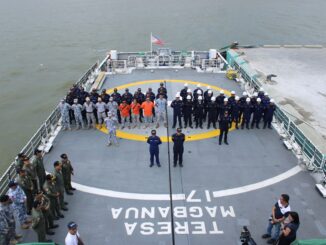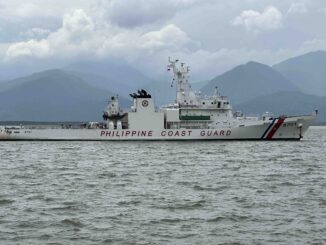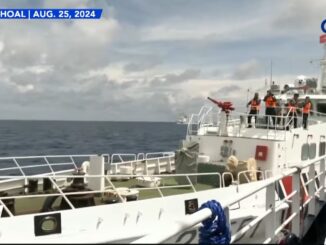
MANILA, Philippines — China’s largest coast guard ship dropped anchor in the vicinity of Escoda (Sabina) Shoal several hundred yards from a Philippine Coast Guard (PCG) vessel which sent out a radio challenge but was ignored, PCG Commodore and spokesman Jay Tarriela said yesterday.
“It’s an intimidation on the part of the China Coast Guard,” Tarriela said at the Saturday News Forum in Quezon City. “We’re not going to pull out and we’re not going to be intimidated.”
The 165-meter “monster” ship of the China coast guard, with bow number 5901, entered the Philippines’ 200-nautical mile exclusive economic zone on July 2, ignoring PCG’s radio query about its intentions.
The Chinese ship cruised near Ayungin (Second Thomas) Shoal and Panganiban (Mischief) Reef before dropping anchor near Escoda Shoal. Panganiban Reef – now reclaimed and functioning as a military base – has been under Chinese control since 1995.
China’s embassy in Manila and the Chinese foreign ministry did not respond to a request for comment. China’s coast guard has no publicly available contact information.
The Chinese ship, which also deployed a small boat, was anchored 800 yards from the PCG’s BRP Teresa Magbanua which was guarding the shoal.
“The distance between the two vessels is less than 800 yards, with the Chinese ship positioned on the starboard beam of the PCG vessel,” Tarriela wrote on X on Friday. Starboard refers to the right side of a ship.
The PCG official also shared a video recording of a female radio operator on Teresa Magbanua issuing radio challenge to the CCG ship. China did not respond to the radio challenge, he said.
He also showed photos of the Monster Ship taken from Teresa Magbanua, a 97-meter multi-role response vessels (MRRV) from Japan.
In May, the PCG deployed the Teresa Magbanua to Escoda Shoal shoal to deter small-scale reclamation by China, which denied the claim. China has carried out extensive land reclamation on some islands in the South China Sea, building air force and other military facilities, causing concern in Washington and around the region.
Earlier, marine science researchers from the University of the Philippines discovered dead corals dumped on Escoda Shoal. The shoal is around 75 nautical miles or 110 kilometers from Palawan’s nearest coastline, Tarriela noted.
‘Dark vessel detection’
Tarriela said the PCG was able to track CCG 5901’s movement using “dark vessel detection technology from Canada.”
Tarriela also said at the forum the Chinese vessel would “loiter and fulfill logistical requirements” around Escoda, where several rigid hull inflatable boats had been detected.
“Regardless of how many CCG vessels they deployed, or whether they were navy vessels, the (PCG) will not be intimidated. We will maintain our presence in Escoda, we will not pull out,” he said.
Several sightings of the ship were reported after the June 17 incident wherein Chinese coast guard personnel took action to disrupt a resupply mission to BRP Sierra Madre in Ayungin Shoal by boarding Filipino boats, destroying their communications and navigational equipment using bladed weapons and clubs.
The PCG has been documenting incidents of Chinese aggression at sea and reporting them to the National Task Force on the West Philippine Sea.
Tarriela, the PCG’s spokesman in the task force, said the documentation is part of the government’s “transparency campaign” against China’s aggression.
Asked if the PCG’s documentation would be used as basis for the filing of another case against China before an international court, Tarriela it’s the Department of Justice or the Office of the Solicitor General which would decide on the matter.
He made it clear that the Philippines – through the Department of Foreign Affairs – “remains open to diplomacy” in dealing with a belligerent China.
He also said it’s not the Philippines that should “deescalate” tensions, as it is “always on the receiving end of the escalatory action” of the CCG. “We are not the ones escalating, we are not provoking anybody. We are just carrying out our patriotic duty of maintaining our presence in the West Philippine Sea,” Tarriela said.
China claims most of the South China Sea, a key conduit for $3 trillion of annual ship-borne trade, as its own territory.
Beijing rejects the 2016 ruling by The Hague-based Permanent Court of Arbitration which said its expansive maritime claims had no legal basis.
Following a high-level dialogue, the Philippines and China agreed on Tuesday on the need to “restore trust” and “rebuild confidence” so they could better manage maritime disputes.





Be the first to comment